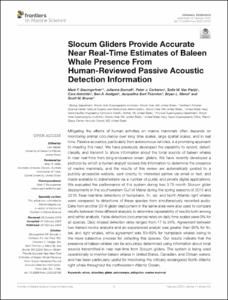| dc.contributor.author | Baumgartner, Mark | |
| dc.contributor.author | Bonnell, Julianne | |
| dc.contributor.author | Corkeron, Peter | |
| dc.contributor.author | Van Parijs, Sofie | |
| dc.contributor.author | Hotchkin, Cara | |
| dc.contributor.author | Hodges, Ben A. | |
| dc.contributor.author | Bort Thornton, Jacqueline | |
| dc.contributor.author | Mensi, Bryan L. | |
| dc.contributor.author | Bruner, Scott M. | |
| dc.coverage.spatial | North Atlantic Ocean | en_US |
| dc.coverage.spatial | North Pacific Ocean | en_US |
| dc.coverage.spatial | Indian Ocean | en_US |
| dc.date.accessioned | 2021-11-19T17:28:46Z | |
| dc.date.available | 2021-11-19T17:28:46Z | |
| dc.date.issued | 2020 | |
| dc.identifier.citation | Baumgartner, M.F., Bonnell, J., Corkeron, P.J., Van Parijs, S.M., Hotchkin, C., Hodges, B.A., Bort Thornton, J., Mensi, B.L. and
Bruner, S.M. (2020) Slocum Gliders Provide Accurate Near Real-Time
Estimates of Baleen Whale Presence From Human-Reviewed Passive Acoustic Detection Information.
Frontiers in Marine Science, 7:100, 12pp. DOI: 10.3389/fmars.2020.00100 | en_US |
| dc.identifier.uri | https://repository.oceanbestpractices.org/handle/11329/1787 | |
| dc.description.abstract | Mitigating the effects of human activities on marine mammals often depends on monitoring animal occurrence over long time scales, large spatial scales, and in real time. Passive acoustics, particularly from autonomous vehicles, is a promising approach to meeting this need. We have previously developed the capability to record, detect, classify, and transmit to shore information about the tonal sounds of baleen whales in near real time from long-endurance ocean gliders. We have recently developed a protocol by which a human analyst reviews this information to determine the presence of marine mammals, and the results of this review are automatically posted to a publicly accessible website, sent directly to interested parties via email or text, and made available to stakeholders via a number of public and private digital applications. We evaluated the performance of this system during two 3.75-month Slocum glider deployments in the southwestern Gulf of Maine during the spring seasons of 2015 and 2016. Near real-time detections of humpback, fin, sei, and North Atlantic right whales were compared to detections of these species from simultaneously recorded audio. Data from another 2016 glider deployment in the same area were also used to compare results between three different analysts to determine repeatability of results both among and within analysts. False detection (occurrence) rates on daily time scales were 0% for all species. Daily missed detection rates ranged from 17 to 24%. Agreement between two trained novice analysts and an experienced analyst was greater than 95% for fin, sei, and right whales, while agreement was 83–89% for humpback whales owing to the more subjective process for detecting this species. Our results indicate that the presence of baleen whales can be accurately determined using information about tonal sounds transmitted in near real-time from Slocum gliders. The system is being used operationally to monitor baleen whales in United States, Canadian, and Chilean waters, and has been particularly useful for monitoring the critically endangered North Atlantic right whale throughout the northwestern Atlantic Ocean. | en_US |
| dc.language.iso | en | en_US |
| dc.rights | Attribution 4.0 International | * |
| dc.rights.uri | http://creativecommons.org/licenses/by/4.0/ | * |
| dc.subject.other | BioICE | |
| dc.subject.other | IOOS Marine Life | |
| dc.title | Slocum Gliders Provide Accurate Near Real-Time Estimates of Baleen Whale Presence From Human-Reviewed Passive Acoustic Detection Information. | en_US |
| dc.type | Journal Contribution | en_US |
| dc.description.refereed | Refereed | en_US |
| dc.format.pagerange | 12pp. | en_US |
| dc.identifier.doi | https://doi.org/10.3389/fmars.2020.00100 | |
| dc.subject.parameterDiscipline | Environment | en_US |
| dc.subject.instrumentType | Passive acoustic recording systems | en_US |
| dc.subject.dmProcesses | Data acquisition | en_US |
| dc.subject.dmProcesses | Data analysis | en_US |
| dc.subject.dmProcesses | Data exchange | en_US |
| dc.subject.dmProcesses | Data delivery | en_US |
| dc.subject.dmProcesses | Data aggregation | en_US |
| dc.bibliographicCitation.title | Frontiers in Marine Science | en_US |
| dc.bibliographicCitation.volume | 7 | en_US |
| dc.bibliographicCitation.issue | Article 00100 | en_US |
| dc.description.sdg | 14.a | en_US |
| dc.description.eov | Marine turtles, birds, mammals abundance and distribution | en_US |
| dc.description.adoption | International | en_US |
| dc.description.ebv | Species Populations | en_US |
| dc.description.ebv | Species Traits | en_US |
| dc.description.ecv | Marine Habitats | en_US |
| dc.description.sensors | Passive Acoustic Recorders | en_US |
| obps.endorsementAuthorDeclared.bestPractice | Best practice | |
| obps.contact.contactname | Mark F. Baumgartner | |
| obps.contact.contactemail | mbaumgartner@whoi.edu | |
| obps.resourceurl.publisher | https://www.frontiersin.org/articles/10.3389/fmars.2020.00100/ | |
 Repository of community practices in Ocean Research, Applications and Data/Information Management
Repository of community practices in Ocean Research, Applications and Data/Information Management

